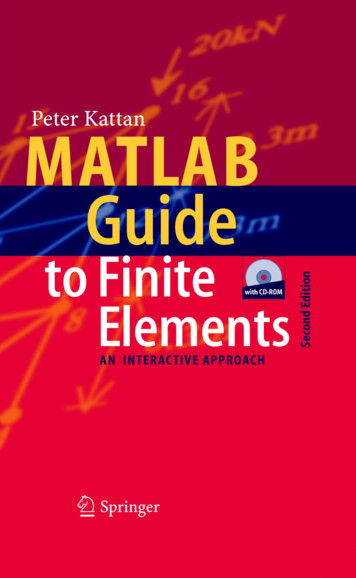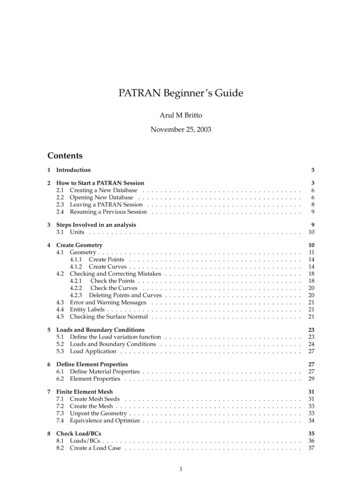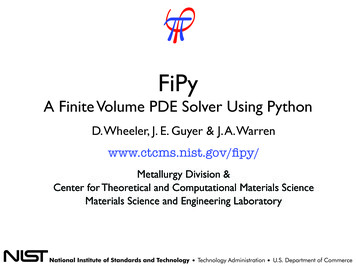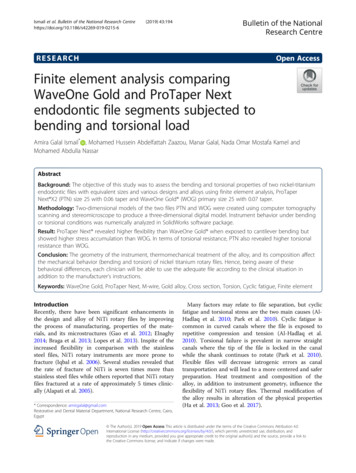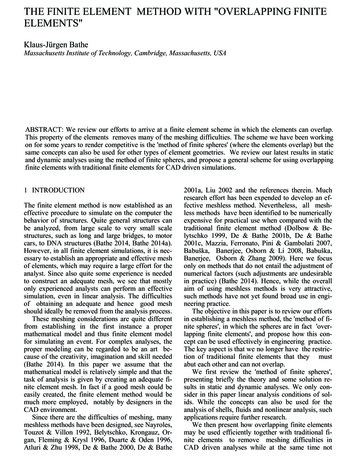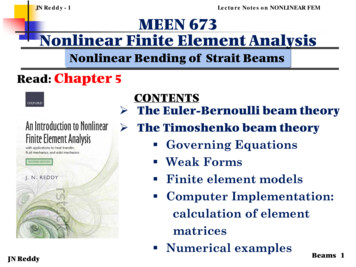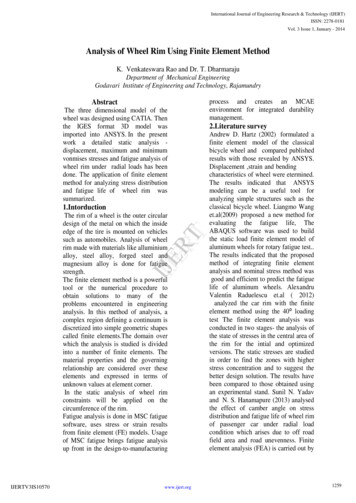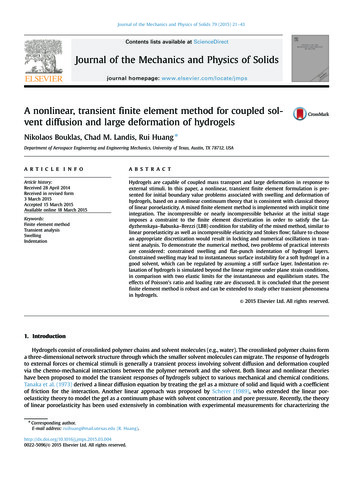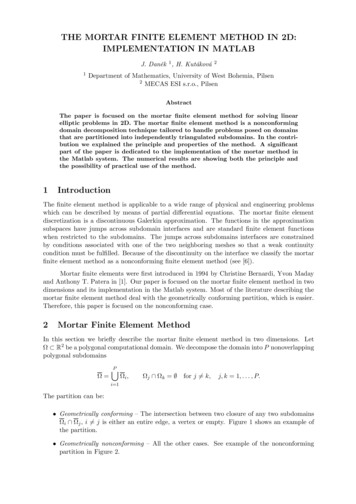
Transcription
Proceedings of the 2017 International Conference on Industrial Engineering and Operations Management (IEOM)Bristol, UK, July 24-25, 2017Finite Element Analysis of a CubesatKudzanai SekerereDepartment of Mechatronic Engineering,Chinhoyi University of Technology,P. Bag 7724, Chinhoyi, Zimbabwe.ksekerere@gmail.comTawanda MushiriDept. of Mechanical Engineering,University of Zimbabwe,P.O Box MP 167, Mt Pleasant, Harare, Zimbabwe.tawanda.mushiri@gmail.comAbstractThis paper aims to analyse the behaviour of a selected aluminium CubeSat frame subjected under static andvibrational loads using finite element analysis. Failures of CubeSats due to instability caused by vibrationduring launch can result in damage of the CubeSats and Launch Vehicle. Hence there is the need to analysethe maximum von-mises stress and strain of the CubeSat before production and launch to avoid thesefailures and losses. The CubeSat is modelled and analysed using Solidworks 2014. Finally, the resultsobtained are an indication of whether or not the frame structure is able to safely withstand the worst-casescenario static loading and imposed failure modes.Keywords: static load, vibrational load, and finite element analysis.1. IntroductionThe CubeSat concept has been developed at Space Systems Development Laboratory (SSDL), Stanford University byProf. Bob Twiggs and his colleagues and students in conjunction with California Polytechnic State University (CalPoly) (Hansen, 2001). The purpose of the paper is to provide a standard for the design of picosatellites to reduce costand development time, increase accessibility to space, and sustain frequent launches. CubeSats are minuscule satellitesdesigned for low earth orbit (LEO) with a purpose to use universities worldwide for space research and exploration(Israr, 2014). Presently, the CubeSat Project is an international collaboration of over 100 universities, high schools,and private firms developing picosatellites containing scientific, private, and government payloads. The size and costof spacecraft vary depending on the application; some you can hold in your hand while others like Hubble are as bigas a school bus. Small spacecraft (SmallSats) focus on spacecraft with a mass less than 180 kilograms and about thesize of a large kitchen fridge. Even with small spacecraft, there is a large variety of size and mass that can bedifferentiated as Minisatellite, 100-180 kilograms; Microsatellite, 10-100 kilograms; Nanosatellite, 1-10 kilograms;Picosatellite, 0.01-1 kilograms and Femtosatellite, 0.001-0.01 kilograms (NASA, 2015). CubeSats are a class ofnanosatellites that use a standard size and form factor. The standard CubeSat size uses a "one unit" or "1U" measuring10x10x10 cms and is extendable to larger sizes; 1.5, 2, 3, 6, and even 12U (NASA, 2015). Figure 1 shows thecubesat. IEOM Society International115
Proceedings of the 2017 International Conference on Industrial Engineering and Operations Management(IEOM) Bristol, UK, July 24-25, 2017Figure 1. Cubesat unitsThe cube-shaped satellites are approximately four inches long, have a volume of about one quart and weigh about 3pounds. To participate in the CSLI program, CubeSat investigations should be consistent with NASA's Strategic Planand the Education Strategic Coordination Framework. The research should address aspects of science, exploration,technology development, education or operations (NASA, 2016).Figure 2. A set of NanoRacks CubeSatsCompared to traditional multi-million-dollar satellite missions, CubeSat projects have the potential to educate theparticipants and implement successful and useful missions in science and industry at much lower costs (Cube sat kit,2013).1.1 Finite Element Analysis of a cubeThe aim of offshore structural engineering is to produce structures which are safe, functional, economical, and able toresist the forces included by man and environment or required period of time. Finite Element Analysis (FEA) is anengineering method of calculating stresses and strains in all materials (Prasad Konda and Tarannum SA, 2012). Lal etal. have dealt with nonlinear free vibration of laminated composite plates on elastic foundation with random systemproperties. The basic formulation of the problem is based on higher-order shear displacement theory including rotatoryinertia effects and von Karman-type Non-linear strain displacement relations. A 𝐶𝐶0 f inite e lement i s u sed f ordescretization of the laminate. A direct iterative method in conjunction with first-order Taylor series basedperturbation technique procedure is developed to solve random nonlinear generalized eigenvalue problem. The IEOM Society International116
Proceedings of the 2017 International Conference on Industrial Engineering and Operations Management (IEOM)Bristol, UK, July 24-25, 2017developed probabilistic procedure is successfully used for the nonlinear free vibration problem with a reasonableaccuracy.Malekzadeh has developed differential quadrature large amplitude free vibration analysis of laminated skew platesbased on FSDT based on the first order shear deformation theory (FSDT) using differential quadrature method (DQM).The geometrical nonlinearity is modeled using Green’s strain and von Karman assumptions in conjunction with theFSDT of plates. After transforming and discretizing the governing equations, which includes the effects of rotaryinertia, direct iteration technique as well as harmonic balance method is used to solve the resulting discretized systemof equations. The effects of skew angle, thickness-to-length ratio, aspect ratio and also the impact due to differenttypes of boundary conditions on the convergence and accuracy of the method are studied. A mesh-free least-squaresbased finite difference (LSFD) method is applied for solving large amplitude free vibration problem of arbitrarilyshaped thin plates by Wu et al. In this approximate numerical method, the spatial derivatives of a function at a pointare expressed as weighted sums of the function values of a group of supporting points. This method can be used tosolve strong form of partial differential equations (PDEs), and it is especially useful in solving problems with complexdomain geometries due to its mesh-free and local approximation characteristics. In this study, the displacementcomponents of thin plates are constructed from the product of a spatial function and a periodic temporal function.Consequently, the nonlinear PDE is reduced to an ordinary differential equation (ODE) in terms of the temporalfunction (Saurabh and Yudhvir Yadav, 2016).Gajbir et al. have studied Nonlinear vibration analysis of composite laminated and sandwich plates with randommaterial properties Nonlinear vibration analysis is performed using a C0 assumed strain interpolated finite elementplate model based on Reddy’s third order theory. An earlier model is modified to include the effect of transverse shearvariation along the plate thickness and Von-Karmann online ar strain terms. Monte Carlo Simulation with LatinHypercube Sampling technique is used to obtain the variance of linear and nonlinear natural frequencies of the platedue to randomness in its material properties. This chaotic nature of the dispersion of nonlinear eigen values is alsorevealed in eigen value sensitivity analysis (Saurabh and Yudhvir Yadav, 2016).Jayakumar et al. have studied on nonlinear free vibrations of simply supported piezo-laminated rectangular plates withimmovable edges utilizing Kirchhoff’s hypothesis and von Karman strain–displacement relations. The effect ofrandom material properties of the base structure and actuation electric potential difference on the nonlinear freevibration of the plate is examined. The study is confined to linear-induced strain in the piezoelectric layer applicableto low electric fields (Saurabh and Yudhvir Yadav, 2016).The von Karman’s large deflection equations for generally laminated elastic plates are derived in terms of stressfunction and transverse deflection function. A review of the recent development of the finite element analysis forlaminated composite plates from 1990 is presented by Zhang et al. The literature review is devoted to the recentlydeveloped finite elements based on the various laminated plate theories for the free vibration and dynamics, bucklingand post-buckling analysis, geometric nonlinearity and large deformation analysis, and failure and damage analysisof composite laminated plates. The material nonlinearity effects and thermal effects on the buckling and post-bucklinganalysis, the first-ply failure analysis and the failure and damage analysis were emphasized specially (Saurabh andYudhvir Yadav, 2016).2. Structural SubsystemThe objective of the structural subsystem for the CubeSat project is to provide a simple, steady structure that willsurvive launch loads, while providing an easily accessible data and power bus for debugging and assembly ofcomponents. Because of the size constraints of the CubeSat and small expense budget, this must be done with thephilosophy of maximizing usable interior space, while minimizing the complexity and cost of the design. The designof the CubeSat conforms to the structural and launcher requirements set by the Stanford/Calpoly CubeSat program.The shape of CubeSat is essentially a cube, with outer dimensions of 10 x 10 x 10 cm, with 3.0 mm clearance aboveeach face of the cube for mounting exterior components such as antenna, data link and power charger inlet port. Themaximum allowable mass of CubeSat is 1 kg, and it is desired that the structure be no more than approximately 30%of the total CubeSat mass, and should be able to withstand a minimum of 50 g’s load (Wells, 2003). IEOM Society International117
Proceedings of the 2017 International Conference on Industrial Engineering and Operations Management (IEOM)Bristol, UK, July 24-25, 20173. Material SelectionLEO satellites are commonly used for communication and earth imaging enclosed by a payload of signal processingmodule only. In designing of LEO satellite, the model is premeditated by an appropriate selection of material basedon low weight, high strength to weight ratio, and space qualified. In addition, basic geometry of the satellite body isalso defined by considering the factors such as heat distribution and heat dissipation, weight of fasteners, accessibilityand maintainability, accommodation of subsystems, centre of gravity, and manufacturing cost.The suggested material for the main satellite structure is Aluminium 7075 or 6061, Stainless Steel, Titanium,Composites, and Honey Comb. If other materials are used, they must have the equal or more value for thermalexpansion and yield strength as the aluminium. Table 1 lists several materials along with their strength, density, andcost for a 12 x 12 inch sheet.Table 1: Material AnalysisMaterialYield Strength DensityStainless g/m32850 kg/m32796 kg/m3̴1000 kg/m38321 kg/m3MachinabilityCost/ft2EasyHardEasyEasyHardHard 6.25 57.40 2.42 2.87 43.80 96.25The above table clearly indicates that AL-6061-T6 and AL-7075-T6 meet the required criteria of high strength, lightweight, easy machinability, and cost; therefore, Aluminium 7075 was chosen as the structural material for the CubeSatframe since it has higher yield strength.4. CubeSat Frame DesignIn short, it is necessary to have a structure that is light, strong, versatile, and easy to disassemble (Campbell, 2002).The CubeSat frame is to be made of 6 aluminium faces of 2mm thickness. The CubeSat frame will have a pumpkinstructure in order to reduce its weight and to make it easier to mount the solar cells and other components. A modelof the frame is created using Solidworks software and it is as shown in figure 3 below.Figure 3: CubeSat Frame5. Finite Element Analysis of CubeSat FrameIn order to properly design and construct a CubeSat, analysis must be performed on CubeSat models. Examples ofsuch “virtual tests” can include a manufacturability test, stress analysis test, and dynamic response analysis test, amongothers. Performing such studies on the models helps to optimize parts for improved performance in the intended IEOM Society International118
Proceedings of the 2017 International Conference on Industrial Engineering and Operations Management (IEOM)Bristol, UK, July 24-25, 2017environment and provides a low-cost solution to testing, in which the computer-based model is tested rather thanmachining the actual CubeSat and testing it multiple times, essentially eliminating multiple field tests. Furthermore,parts can be optimized for mass by performing stress analysis tests on the models to determine the minimum massneeded to have adequate structural strength.5.1 Stress AnalysisThe greatest stress occurs during launch hence the force likely to be experienced by the CubeSat during launch is tobe modelled and analysed using Solidworks simulation.Figure 4: Finite Element Analysis on the CubeSat’s Frame for stress AnalysisThe results provided us with von Mises stress varying from 0.802 𝑁𝑁𝑚𝑚2 to approximately 16038.221𝑁𝑁𝑚𝑚2. Even if thestress had reached the largest value on the scale, approximately 24056.932𝑁𝑁𝑚𝑚2, the yield strength of the Al 7075 T6is 5.05e 008 N/m 2. The areas affected the most by the von Mises stress occur on the centre of the top Face of theCubeSat. The test showed that the material used on the Pumpkin structure, assumed for the CubeSat, should be ableto withstand the vibrational loads throughout the launch period for any of the launch vehicles likely to be used.5.2 Strain and Deformation AnalysisThe next area of concern was the deformation that occurs during launch from random vibrations and static loads. Ifthe loads are too great, the structure could deform and cause massive damage to the internal components. SolidWorkswas able to produce values for the worst-case scenario. IEOM Society International119
Proceedings of the 2017 International Conference on Industrial Engineering and Operations Management(IEOM) Bristol, UK, July 24-25, 2017Figure 5: Finite Element Analysis on the CubeSat’s Frame for Displacement AnalysisThe results showed a scaled bowing of the structural top face inwards. But when the values of the physical deformationare looked at, they only vary slightly. These values are extremely small and can be considered negligible with respectto the integrity of the structure during launch, as this set of results represents a worst-case scenario. The critical pointsof deformation seem to occur once again in the central region of the structure, but seem to pose no threat as the materialis strong enough to withstand the loads.Figure 6: Finite Element Analysis on the CubeSat’s Frame for Static Strain Analysis IEOM Society International120
Proceedings of the 2017 International Conference on Industrial Engineering and Operations Management (IEOM)Bristol, UK, July 24-25, 20176. ConclusionIn a nutshell, the CubeSat Frame structure is able to withstand the launch static and dynamic vibrations without failing.This preliminary finite element analysis has revealed a significant margin of safety and adequate survivability in termsof worst-case static loading and imposed failure modes.7. RecommendationThe acoustic vibrations appear to induce the most critical dynamic response. In this case, the maximum deflections atthe center of the plate were observed to occur at the entities fundamental frequency. It is recommended thatcomponents mounted at the center of these plates be appropriately bonded and inspected after environmental testing.ReferencesCampbell, T. D.-A. M. M. M. S. A. a. T. J., 2002. “CanSat 2002, Texas: Department of AerospaceEngineering and Engineering Mechanics, The University of Texas at Austin.Cube sat kit, 2013. Cube Sat Kit. [Online]Available at: http://www.cubesatkit.com/[Accessed 31 May 2017].Hansen, F., 2001. CubeSats, Lyngby: Danish Space Research Institute.Israr, A., 2014. Vibration and Modal Analysis of Low Earth Orbit Satellite. Shock and Vibration , Volume2014, pp. 1-8.NASA, 2015. What are SmallSats and CubeSats?. [Online]Available at: d-cubesats[Accessed 31 May 2017].NASA, 2016. Cubesats. [Online]Available at: https://www.nasa.gov/mission pages/cubesats/overview[Accessed 31 May 2017].Prasad Konda and Tarannum SA, 2012. Basic principles of finite element method and its applications inorthodontics. Journal Of Pharmaceutical and Biomedical Sciences, 16(16), pp. 1-8.Saurabh and Yudhvir Yadav, 2016. Literature Review on Finite Element Method. International Journal ofEnhanced Research in Science, Technology & Engineering, 5(3), pp. 267-269.Wells, G. J. S. L. a. J. T., 2003. Canada’s Smallest Satellite: The Canadian, s.l.: University of TorontoInstitute for Aerospace Studies.BiographyKudzanai Sekerere is a student who recently completed a Bachelor of Engineering (Honours) Degree inMechatronics at the Chinhoyi University of Technology in Zimbabwe. He has interned for a year with the ZimbabwePower Company where he has attained experience in thermal power generation. His main interests are in the fields ofindustrial automation, instrumentation and control and robotics.Tawanda Mushiri is a PhD student at the University of Johannesburg in the field of fuzzy logic systems, finiteelement and maintenance, is a Lecturer at the University of Zimbabwe teaching Machine Dynamics, Solid Mechanicsand Machine Design. His research activities and interests are in Artificial intelligence, Automation, Design andMaintenance engineering Contacted at tawanda.mushiri@gmail.com IEOM Society International121
A review of the recent development of the finite element analysis for laminated composite plates from 1990 is presented by Zhang et al. The literature review is devoted to the recently . of the frame is created using Solidworks software and it is as shown in figure 3 below. Figure 3: CubeSat Frame . 5. Finite Element Analysis of CubeSat Frame
